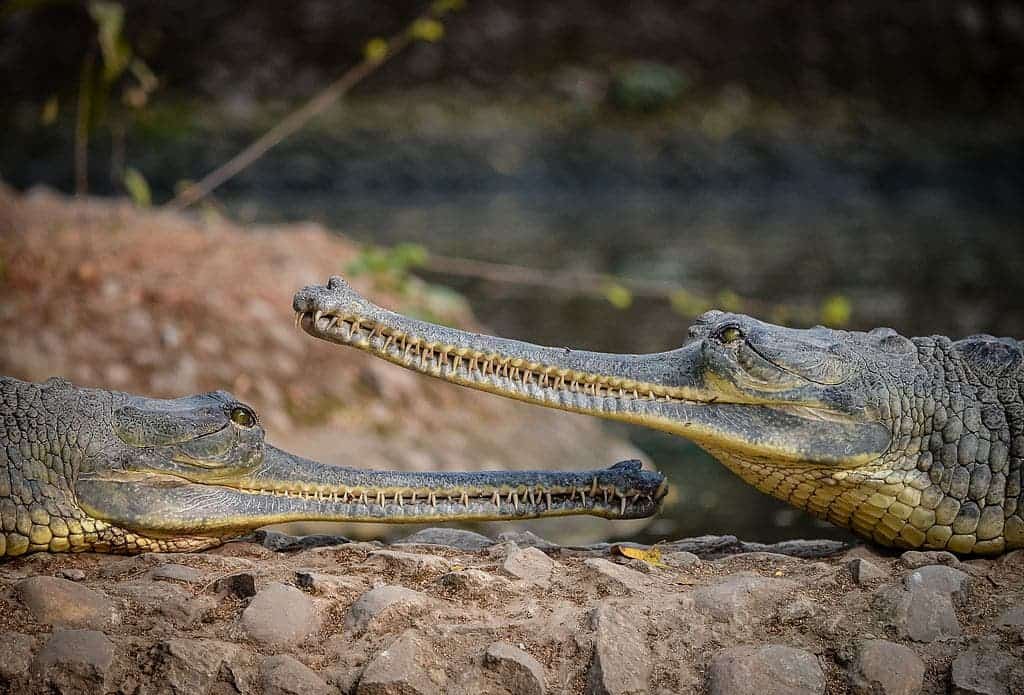In the rivers of India and Nepal, a long and thin snout with over 100 teeth swims below the surface. It’s the gharial, the longest of all crocs, reaching 12 to 15 feet in length (3.5-4.5 meters), and it’s quite a sight to behold. These crocs have been swimming in these waters since the Cretaceous period (140 million years ago) but they are now in big trouble, a new study points out.

A close look at these unique crocs
Phoebe Griffith, a conservation biologist working at the Zoological Society of London, built a global trait database for all existing crocodilians and just published the results. The researchers found that gharials are among the most distinctive of the world’s crocodilians, the one with the most unusual ecological role among all 28 croc species. Being so specialized is not good news for them.
“Gharials are critically endangered, they are mostly aquatic, big-sized (believed to be) fish-eating crocodiles that live mostly in the river,” Griffith told Mongabay this week. “We used data from the IUCN (International Union for Conservation of Nature) Red List as well as data from ongoing assessments of crocodilians around the world.”
For their study, Griffith and her colleagues first looked at measurable features of all croc species linked to how each of them functions in their environments, such as size and habitat use. Then they assigned scores based on the traits that influence aspects of their functioning in the ecosystem and their uniqueness in an evolutionary sense.
This allowed the researchers to identify four functional groups of crocodiles that had similar ecological roles. However, the gharial stood out due to its unique ecological functions and didn’t fit in any of the groups. This gave the researchers the idea of creating a metric to guide efforts to prioritize crocodile species for conservation.
They combined the species’ “functional diversity” scores with the level of threat each species face to create a metric known as EcoDGE, or ecologically distinct and globally endangered. Gharials (Gavialis gangeticus) scored the highest, now categorized as critically endangered by IUCN, followed by the Chinese alligator (Alligator sinensis).
Gharial’s numbers have plunged as much as 98% since the 1940s due to their hunting for medicine and changes to freshwater habitats. For example, people have altered the flow of rivers, causing areas to dry out and making it more difficult for gharials to survive. Young gharials are also caught in fishing nets, leading to injuries or death.
A number of conservation efforts have tried to help the croc species in recent decades. India granted it full protection in the 1970s, hoping to reduce poaching, and conservation organizations launched rear and release programs that introduced captive-bred crocs. However, its success isn’t clear due to the lack of monitoring.
However, it’s not only the gharials that need urgent conservation efforts, with 15 out of 28 croc species currently threatened with extinction. The metric created by the researchers suggests that species such as the Philippine crocodile (Crocodylus mindorensis) and the Siamese crocodile (Crocodylus siamensis) also have to be prioritized.
“Our research shows that we can safeguard much of the diversity we stand to lose by prioritizing the most unique species for conservation action,” co-author Rikki Gumbs told Mongabay. “Interestingly, we can also efficiently protect the threatened functions of crocodilians by aiming to conserve their evolutionary history.”
The study was published in the journal British Ecological Society.









